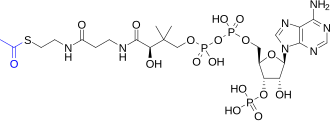Citric acid cycle


Citric Acid Cycle
The citric acid cycle, also known as the Krebs cycle or the tricarboxylic acid (TCA) cycle, is a series of chemical reactions used by all aerobic organisms to generate energy through the oxidation of acetate derived from carbohydrates, fats, and proteins into carbon dioxide and ATP. The cycle is a key component of the metabolic pathway by which all aerobic organisms generate energy.
Overview[edit]
The citric acid cycle takes place in the mitochondria of eukaryotic cells and in the cytoplasm of prokaryotic cells. It is a central part of cellular respiration, which also includes glycolysis and the electron transport chain.
Steps of the Citric Acid Cycle[edit]
The cycle consists of eight main steps:
- **Citrate Synthase**: Acetyl-CoA combines with oxaloacetate to form citrate.
- **Aconitase**: Citrate is converted into isocitrate.
- **Isocitrate Dehydrogenase**: Isocitrate is oxidized to alpha-ketoglutarate, producing NADH and carbon dioxide.
- **Alpha-Ketoglutarate Dehydrogenase**: Alpha-ketoglutarate is converted to succinyl-CoA, producing NADH and carbon dioxide.
- **Succinyl-CoA Synthetase**: Succinyl-CoA is converted to succinate, producing GTP (or ATP).
- **Succinate Dehydrogenase**: Succinate is oxidized to fumarate, producing FADH2.
- **Fumarase**: Fumarate is converted to malate.
- **Malate Dehydrogenase**: Malate is oxidized to oxaloacetate, producing NADH.
Importance[edit]
The citric acid cycle is crucial for the production of energy in the form of ATP. It also provides intermediates for the synthesis of various compounds, including amino acids, nucleotides, and other essential molecules.
Regulation[edit]
The cycle is tightly regulated by the availability of substrates and feedback inhibition by its products. Key regulatory enzymes include citrate synthase, isocitrate dehydrogenase, and alpha-ketoglutarate dehydrogenase.
Related Pathways[edit]
The citric acid cycle is interconnected with several other metabolic pathways, including:
History[edit]
The cycle was first identified by Hans Adolf Krebs in 1937, for which he was awarded the Nobel Prize in Physiology or Medicine in 1953.
See Also[edit]
References[edit]
<references group="" responsive="1"></references>
External Links[edit]

This article is a biochemistry stub. You can help WikiMD by expanding it!
Ad. Transform your life with W8MD's Budget GLP-1 injections from $75


W8MD offers a medical weight loss program to lose weight in Philadelphia. Our physician-supervised medical weight loss provides:
- Weight loss injections in NYC (generic and brand names):
- Zepbound / Mounjaro, Wegovy / Ozempic, Saxenda
- Most insurances accepted or discounted self-pay rates. We will obtain insurance prior authorizations if needed.
- Generic GLP1 weight loss injections from $75 for the starting dose.
- Also offer prescription weight loss medications including Phentermine, Qsymia, Diethylpropion, Contrave etc.
NYC weight loss doctor appointmentsNYC weight loss doctor appointments
Start your NYC weight loss journey today at our NYC medical weight loss and Philadelphia medical weight loss clinics.
- Call 718-946-5500 to lose weight in NYC or for medical weight loss in Philadelphia 215-676-2334.
- Tags:NYC medical weight loss, Philadelphia lose weight Zepbound NYC, Budget GLP1 weight loss injections, Wegovy Philadelphia, Wegovy NYC, Philadelphia medical weight loss, Brookly weight loss and Wegovy NYC
|
WikiMD's Wellness Encyclopedia |
| Let Food Be Thy Medicine Medicine Thy Food - Hippocrates |
Medical Disclaimer: WikiMD is not a substitute for professional medical advice. The information on WikiMD is provided as an information resource only, may be incorrect, outdated or misleading, and is not to be used or relied on for any diagnostic or treatment purposes. Please consult your health care provider before making any healthcare decisions or for guidance about a specific medical condition. WikiMD expressly disclaims responsibility, and shall have no liability, for any damages, loss, injury, or liability whatsoever suffered as a result of your reliance on the information contained in this site. By visiting this site you agree to the foregoing terms and conditions, which may from time to time be changed or supplemented by WikiMD. If you do not agree to the foregoing terms and conditions, you should not enter or use this site. See full disclaimer.
Credits:Most images are courtesy of Wikimedia commons, and templates, categories Wikipedia, licensed under CC BY SA or similar.
Translate this page: - East Asian
中文,
日本,
한국어,
South Asian
हिन्दी,
தமிழ்,
తెలుగు,
Urdu,
ಕನ್ನಡ,
Southeast Asian
Indonesian,
Vietnamese,
Thai,
မြန်မာဘာသာ,
বাংলা
European
español,
Deutsch,
français,
Greek,
português do Brasil,
polski,
română,
русский,
Nederlands,
norsk,
svenska,
suomi,
Italian
Middle Eastern & African
عربى,
Turkish,
Persian,
Hebrew,
Afrikaans,
isiZulu,
Kiswahili,
Other
Bulgarian,
Hungarian,
Czech,
Swedish,
മലയാളം,
मराठी,
ਪੰਜਾਬੀ,
ગુજરાતી,
Portuguese,
Ukrainian